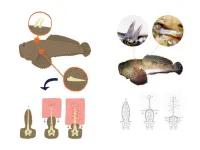(Press-News.org) URBANA, Ill. — Meat processing plants in the U.S. have garnered considerable public attention in recent years, often focusing on production and labor issues. The COVID-19 pandemic underscored the vulnerability of large, concentrated plants, as major shutdowns led to reduced output and higher meat prices for consumers.
Policy makers have launched initiatives at the state and federal levels to increase meat processing capacity and industry resilience, often favoring small and medium-sized plants. But little research exists to determine what factors make plants more likely to succeed. A new study from the University of Illinois Urbana-Champaign looks at meat processing plants across the United States, aiming to identify characteristics associated with plant survival and provide crucial information for legislators.
“Even before the pandemic, there was a lot of focus on concentration in meat processing. When the pandemic hit, plants with thousands of workers shut down due to COVID outbreaks. Meat processing capacity was reduced by about 40% at the height of the lockdowns, and ongoing efforts to break up plants were intensified,” said Sarah Low, professor and head of the Department of Agricultural and Consumer Economics, part of the College of Agricultural, Consumer and Environmental Sciences at Illinois. Low is co-author on the study, published in the Journal of the Agricultural and Applied Economics Association.
“Our goal was to understand what factors are associated with plant survival, so we could better inform policymakers who want to invest in these plants,” Low added.
The researchers analyzed data from 1997 to 2020 for U.S. non-poultry meat processors with more than five employees (poultry was excluded due to a unique industry structure). The analysis included 7,839 plants, focusing on plant-level characteristics, local context, and concentration.
The study showed the majority of meat processing plants are located in the Eastern half of the U.S., although small and medium plants are more dispersed throughout the states. Many plants are clustered around major cities in proximity to large customer bases and available workforce — in fact, 86% of plants are located in metro or metro-adjacent counties.
The researchers found the average plant survived 9.7 years and 62% of the plants failed at some point during the study period, with small and medium plants more likely to fail than large plants.
“We did find a difference in factors associated with survival for the small and medium plants, compared to the large plants, as well as for urban versus rural plants. For small plants, survival was closely related to business diversification. If they added a retail or wholesale meat market, they were more likely to survive,” explained Catherine Isley, senior business analyst at The Context Network and lead author on the study.
“For larger plants, we found that local context, including workforce-related variables, was more closely related to plant survival. We didn’t find much evidence for the impact of concentration, except for large non-metro plants, where concentration was related to increased survival. This finding suggests that policies aiming to support small and medium meat processors by breaking up larger processors might negatively impact output and industry capacity,” she stated.
If plants are spread out across the country, then workers would have to be spread out as well, Low noted. “There are locations in Nebraska or Kansas, where whole communities are set up to serve immigrant workers. If you want to break up these big processors and have plants in small towns, who's going to work there? We currently have a shortage of labor nationwide, and many plants rely on an immigrant workforce,” she said.
Policy initiatives for large plants need to address labor availability issues and support the labor force effectively, Low and Isley pointed out. This could include, for example, increasing the number of visas for immigrant workers, training new workers, improving working conditions, and investing in research and development to automate processes.
For small and medium plants, there is a different set of policy implications.
“To allocate federal or state dollars in the most efficient way, it would make sense to support plants that are diversified and more likely to survive,” Isley said. “But on the flip side, the goal might be to support plants that are more likely to fail, because otherwise those local communities wouldn't have a plant. However, this approach would only work in areas where the market can support value-added niche products. There’s not necessarily a one-size-fits-all solution for small plants.”
The researchers also found that small plants managed by women in rural areas are less likely to survive. Thus, an additional target for investments could be technical assistance for very small women-operated plants in rural areas, including entrepreneurial training and ecosystem building. Low suggests leveraging the expertise of Cooperative Extension Services, such as Illinois Extension, which are uniquely positioned to provide support and resources for small businesses in local areas.
Editor’s Notes:
The article, “Meat processing plant survival: The role of plant and regional characteristics,” is published in the Journal of the Agricultural and Applied Economics Association [doi.org/10.1002/jaa2.55]. Authors are Catherine Isley and Sarah Low. This research was supported in part by USDA OCE cooperative agreement #58-0111-21-009, “State and Regional Farm Financial Analysis” and by the Missouri Ag. Experiment Station and University of Missouri Extension.
The College of Agricultural, Consumer and Environmental Sciences (ACES) at the University of Illinois has top-ranked programs, dedicated students, and world-renowned faculty and alumni who are developing solutions to the world’s most critical challenges to provide abundant food and energy, a healthy environment, and successful families and communities.
END
Meat processing plants: What factors are critical for survival?
2023-06-13
ELSE PRESS RELEASES FROM THIS DATE:
CHOP researchers develop universal MHC molecules that can be produced rapidly at scale
2023-06-13
Philadelphia, June 13, 2023— Class I major histocompatibility complex (MHC-I) proteins play an essential role in the immune system of all jawed vertebrates. The MHC-I displays peptide fragments of proteins from within the cell on the cell surface, “presenting” them to the immune system, which is constantly scanning the body for foreign or toxic antigens. When foreign peptides are identified, they trigger a cascade that allows cytotoxic T cells to eliminate intruders. This process has been exploited in the development of both vaccines ...
Peptide from venomous fish toxin controls lung inflammation in mice
2023-06-13
A molecule found in the venomous toadfish Thalassophryne nattereri has proved capable of controlling lung inflammation and could be the basis for a more effective asthma drug. The research was supported by FAPESP and conducted by scientists at Butantan Institute in São Paulo, Brazil. An article describing the results is published in the journal Cells.
A welter of fish species live in freshwater, seawater and a mixture of the two, and some of them are venomous. They have spines or stingers connected to venom glands, which ...
Residents in 'digital deserts' have fewer health care options
2023-06-13
Residents in rural counties with limited access to high-speed internet cannot take advantage of increasingly popular online health services.
A new study by the University of Cincinnati highlighted disparities in access to digital technology that could widen the gap in access to health care. The study found that socially vulnerable communities in the United States face more barriers to adequate health care, live in areas with fewer health care resources and have less access to high-speed internet.
The study was published in the journal Mayo Clinic Proceedings: Digital Health.
The Biden Administration announced this year it will invest $73 million in outreach ...
Different genes are expressed at different stages during pregnancy, according to scientists
2023-06-13
We have a good understanding of how a woman’s external features can change during pregnancy, but scientists know surprisingly little about what biological changes occur internally.
A new Northwestern Medicine study, published June 5 in the journal Frontiers in Immunology, provides data about immune cells and biological changes (gene expression) in pregnant people at multiple timepoints before and during pregnancy. Using RNA sequencing and computational methods to estimate proportions of different activated types of immune cells in blood the team of scientists showed how pregnancy induces progressive changes in the maternal ...
USC Stem Cell’s journey towards 1,000 mini-kidneys begins with $1 million from KidneyX
2023-06-13
To help patients in need of transplants, artificial kidneys would have to function like their natural counterparts, but they wouldn’t necessarily have to look like them. With a new $1 million prize from the Kidney Innovation Accelerator, or KidneyX, a team of USC Stem Cell scientists led by Nils Lindström in collaboration with Leonardo Morsut are on a quest to build a kidney that resembles the real thing in function, but not in form.
“Nature has taught us that kidneys can come in an ...
Retooling the ribosomal translation machine could expand chemical repertoire of cells
2023-06-13
Synthetic biologists have become increasingly creative in engineering yeast or bacteria to churn out useful chemicals — from fuels to fabrics and drugs — beyond the normal repertoire of microbes.
But a multi-university group of chemists has a more ambitious goal: to retool the cell's polypeptide manufacturing plants — the ribosomes that spin amino acids into protein — to generate polymer chains that are more elaborate than what can now be made in a cell or a test tube.
The $20 million research enterprise centered at the University of California, Berkeley, is ...
Sickle cell disease is 11 times more deadly than previously recorded
2023-06-13
A new analysis provides a more complete picture of sickle cell disease mortality burden by combining disease prevalence data in different age groups and trends in overall survival when factoring in resulting secondary conditions.
When looking across all deaths, sickle cell disease is a leading cause of mortality in children under 5 years as well as in youth 5–14 years and adults 15–49 years.
Half a million babies were born with sickle cell disease in 2021, and 79% of these infants were in sub-Saharan Africa.
The largest increases ...
New approaches to evaluating water interventions around the globe
2023-06-13
Billions of people around the world face water insecurity. Although there are numerous projects from governments, NGOs, and private corporations who are committed to providing safely managed water and sanitation by 2030, a new study advocates for more holistic evaluation of water, sanitation, and hygiene (WASH) interventions.
According to the study by Justin Stoler, associate professor in the University of Miami College of Arts and Sciences Department of Geography and Sustainable Development, issues ...
ASCAP introduces slate of AI initiatives to help music creators navigate the future while protecting their work
2023-06-13
NEW YORK, June 13, 2023 – With the potential for artificial intelligence (AI) to create both massive disruption and great opportunity within the music industry, ASCAP — the only US PRO that operates on a not-for-profit basis — is introducing a slate of AI initiatives to help music creators navigate the future while protecting their work. These newly announced initiatives include: adoption by the ASCAP Board of Directors of a set of key ASCAP AI principles, creator education, startup incubation and policy development. Building upon ASCAP’s strong ...
Study in mice links heat-damaged DNA in food to possible genetic risks
2023-06-13
Researchers have newly discovered a surprising and potentially significant reason why eating foods frequently cooked at high temperatures, such as red meat and deep-fried fare, elevates cancer risk. The alleged culprit: DNA within the food that’s been damaged by the cooking process.
As shown for the first time known to the authors, this study by Stanford scientists and their collaborators at the National Institute of Standards and Technology (NIST), the University of Maryland, and Colorado State University reveals that components of heat-marred DNA can be absorbed during digestion and incorporated into the DNA of the consumer. That uptake directly ...






